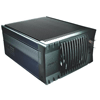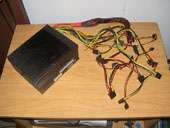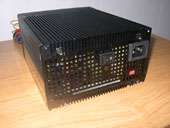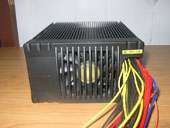- Qualcomm Launches Snapdragon 4 Gen 2 Mobile Platform
- AMD Launches Ryzen PRO 7000 Series Mobile & Desktop Platform
- Intel Launches Sleek Single-Slot Arc Pro A60 Workstation Graphics Card
- NVIDIA Announces Latest Ada Lovelace Additions: GeForce RTX 4060 Ti & RTX 4060
- Maxon Redshift With AMD Radeon GPU Rendering Support Now Available
Antec Phantom 500W Power Supply

Power supplies are an important part of our PC and should never be overlooked. Antec is one of the top makers in the market, due to their stability and build quality. We are taking a look at their 500W Phantom and see how it stands up to a Dual Core system.
Page 3 – Testing and Conclusion
- Intel System
- CPU: Pentium D 820 @ 3.65GHz on AIR
- Motherboard: ASUS P5WD2 Premium w/ 0606 BIOS
- Memory: OCZ 1GB Gold PC2-5400 XTC 4-4-4-12
- Video: eVGA 7800GT 256MB PCI-E @ 490/1.15
- Sound: Realtek HD Audio (Onboard)
- Storage: WD 200GB 7200 8MB
- Odds and Ends: External WD 200GB 7200 8MB via USB2.0
- Etcetera: Windows XP Professional SP2, Windows x64 Professional SP1, NVIDIA 81.98 Drivers
The system being used has an overclocked CPU (Stock 2.8GHz to OC 3.65GHz) and GPU (Stock 445/1.10 to 490/1.15) in order to help push the PSU further. A variety of tools were used over a three hour period in order to stress the system, including both CPU Cores. Programs were run in no real order, but were immediate after one another. Here is the list I used, in alphabetical order:
- 3D Mark 01, 05 and 06
- EVEREST Ultimate Edition – Memory benchmarks
- HD Tach – Stressing the hard disks
- PC Mark 05
- Prime 95 – Run on CPU Core 1
- Super Pi 1.4 Mod – One instance on both CPU Cores
There were no less than two tests running at a given time. At one point, Super Pi, 3D Mark 05 looped and HD Tach were running at the same time, which resulted in a very, very slow computer :)
It wasn’t about getting high scores, but rather pushing the system to the best of my ability. The latest version of EVEREST includes an option to log Sensor outputs, which is how I received the Minimum, Maximum and Average results for each rail. Since Motherboard Monitor is pretty much extinct now, I was extremely happy to see that the latest version could do this.
Here is a look at how the +3.3, +5 and +12 rails performed during the three hours:

These are some extremely pleasing results. There was only a 0.11 Delta on the +12V rail, which is the best we’ve seen on the site to date. I pushed a lot on the PSU and it performed just as I had hoped. This is definitely one stable power supply.
The Phantom is extreme in two cases.. stability and noise level. As seen in our stress testing, the unit is more than capable of handling our systems load.
Who can benefit from the Phantom 500? If you are keen on keeping a quiet system, then this is definitely your ticket. Even though the Phantom 500 includes a fan, it could easily be considered a ‘fanless PSU’ as you may never, or at least rarely see the fan turn on. A fan certainly isn’t a bad thing; it’s a failsafe in case the unit does get too hot, but is completely silent the rest of the time. If your computer is not that well ventilated though, then the fan will likely operate constantly, which makes this not that appropriate for an HTPC. If you are thinking along the lines of HTPC though, then the Phantom 350 may be a good bet.
This PSU does have it’s share of minor issues though, but that’s all they are… minor. The first may be the price, $160US at NewEgg. While that is a little steep, you are paying for extreme stability and reliability. The build quality is superb, and it counts as a workout when you install it! The only negative thing about the Phantom that stands out in my mind are the cables. The motherboard cable is the only one that’s sleeved, and that’s too bad. The rest of the cables are extremely cluttered and I could not untangle most of them because cables were intertwined at the base. For the price of the unit, it would have been great if all the cables were sleeved and organized properly.
Overall, this is a fantastic PSU that you should consider if you are looking for stability, quietness and the combination of the two. I award the Antec Phantom 500 a 9/10 and our Editors Choice award.
If you wish to discuss this review in our forums, please feel free to check out this thread. You do not need to register to reply to content threads.


|
|
Support our efforts! With ad revenue at an all-time low for written websites, we're relying more than ever on reader support to help us continue putting so much effort into this type of content. You can support us by becoming a Patron, or by using our Amazon shopping affiliate links listed through our articles. Thanks for your support!








